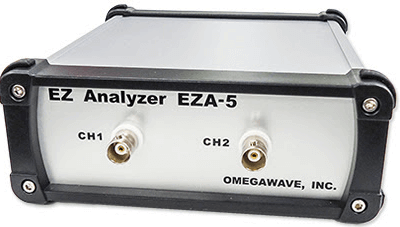What Is a Fast Fourier Transform (FFT) Analyzer?

A fast Fourier transform (FFT) analyzer is an instrument that performs an FFT analysis. Various types of vibration can occur in machinery and buildings and the FFT analyzer can be used to determine the cause of the vibration and ways of reducing it.
While spectrum analyzers and memory recorders are similar instruments to the FFT analyzer, the FFT analyzer is mainly used to observe the frequency components of low-frequency signals.
Uses of Fast Fourier Transform (FFT) Analyzers
FFT analyzers are often used for vibration analysis of machinery, equipment, and buildings. Acceleration pickups are attached to the object to be measured, converted into electrical signals, and input ted into the fast Fourier transform (FFT) analyzer for processing and analysis of the frequency components. By checking the vibration and resonance frequencies generated by machines and buildings, it is possible to reinforce the structure and suppress vibration in order to prevent fatigue failure. Changing the order this way clarifies the causal relationship between reinforcing the structure, suppressing vibration, and preventing fatigue failure.
Another use is in the uneven rotation of motors: FFT analysis of motor vibration can be used to determine the source of vibration. For example, it can help to determine whether the vibration is coming from the motor’s rotating shaft (rotor), the gears, or the bearings.
Another area where FFT can be used is in speech analysis. It can be used to identify the sound regions produced by people or musical instruments, or to analyze the frequency of noise to determine the location and equipment from which the sound is emanating. In this case, the sound is passed through an amplifier using a microphone, and the signal is converted and amplified for FFT analysis.
Recently, the development of office equipment and home appliances is another area where FFT is utilized, for example in evaluating the quietness of products and studying noise sources and their countermeasures. Since it is also used to identify noise sources for low-frequency signals, it is also applied to noise countermeasures for products that handle frequency signals.
Principle of Fast Fourier Transform (FFT) Analyzers
The fast Fourier transform is based on the theory of the Fourier series proposed by the French mathematician Jean-Baptiste Joseph Fourier. The theory of Fourier series states that any complex waveform with periodicity can be represented by a series of simple sine (sin) and cosine (cos) waves.
In general, it is not known how much of the signal to be actually measured is periodic. Therefore, the Fourier transform cuts an appropriate amount of time from the observed waveform and assumes that the cut waveform is an infinitely repeating signal. In the early days of the Fourier transform, the calculation of the Fourier transform required an enormous number of multiplications. However, J.W. Turkey and J.W. Cooley proposed a method to reduce the number of calculations by taking the number of data to the nth power of 2. For example, if the number of data is 1,024, the number of calculations is reduced from 1,024 × 1,024 = 1,048,576 times to 10,240 times. This method is called the Fast Fourier Transform, and FFT is its acronym.
A typical waveform can be represented by three parameters: amplitude, frequency (or period), and phase (time difference). By applying FFT to this principle and using an FFT analyzer, an input waveform signal with time on the horizontal axis is transformed into a graph with frequency on the horizontal axis and amplitude of the waveform at each frequency on the vertical axis.
Difference Between a Fast Fourier Transform (FFT) Analyzer and a Spectrum Analyzer
The first difference between an FFT analyzer and a spectrum analyzer is the range of frequencies they can handle. Spectrum analyzers handle a very wide frequency range of 10 kHz to 10 GHz. Some recent models can handle up to 50 GHz.
Another difference in usage is that fast Fourier transform analyzers are used when it is not known what frequency components are present, whereas spectrum analyzers are used to analyze the frequency components of known high-frequency signals (e.g., cellular phones and Wi-Fi transmitters).
Looking at the difference between the two in terms of the structure of the devices, a spectrum analyzer conventionally consists of analog circuits, whereas an FFT Analyzer uses an AD converter to digitize the obtained waveform and then performs an FF process to calculate the frequency and intensity distribution.